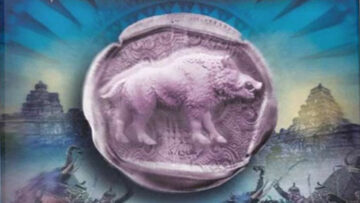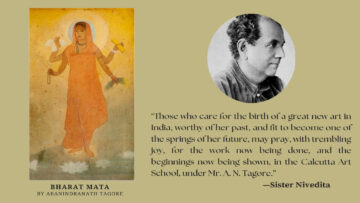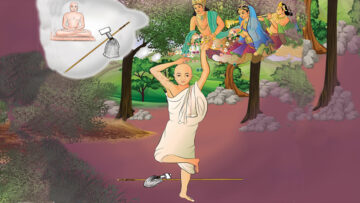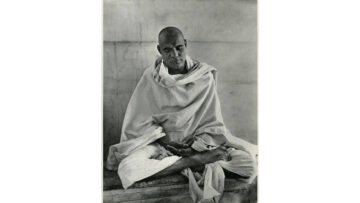Acarya Tulsi and Acarya Mahapragna
Acarya Tulsi, the ninth acarya of Terapantha sect established by Acarya Bhiksu, was born on October 20, 1914. He received initiation on December 5, 1925 in Ladnu, Rajasthan. Assuming the role of acarya on August 27, 1936 he started the Anuvrata movement on March 2, 1949.
Initially, Anuvrata movement was aimed at reforming contemporary society. It built an environment of moral awareness by raising a strong tone against elements that disfigure society – corrupt practices, superstitions and senseless rigid traditions. While doing so, Tulsi realized that reforms are important but no reforms can last in the midst of structural challenges.
Anuvrata (Anu – subtleness/minuteness, Vrat – power of determination) is an ideology of life. It is a view of society based on human values or character. It is not opposed to science and technology. It is opposed to lack of self-restraint. Anuvrata is the path of self-restraint. Anuvrata directs man to refine or purify life and does not ask them to renounce the world. It serves as a code of conduct, guiding all human beings to tread the path of self-restraint. It is pertinent to present life. In today’s world, marked by violence, terrorism, war, hostility, communal strife etc., Anuvrata’s principles gain even greater relevance. Politics is being played in the name of religion while ethical values are being sidelined in professional competition. Electoral misconduct is challenging the fabric of the society. In such a scenario, Anuvrata offers guidance, urging individuals to discipline themselves through unwavering faith and adherence, thereby fostering personal growth and societal harmony.
The ideology of Anuvrata fundamentally revolves around the philosophy of self-restraint. The principle of limited accumulation (of wealth) and restraint from excessive indulgence in pleasures strikes a severe blow at the roots of economic evils. Restrained use of the earth’s resources, water and vegetation can prevent the pollution of the environment. This paradigm of living can be implemented in all the spheres of life, such as education, business, politics and so on. Even though this view is accepted in principle, in actual life, restraint is not exercised to the desired extent. The fundamental reasons for this are the counteracting forces and lack of ability to go against the prevalent current.
Tulsi emphatically proclaimed that religion and sect are two different things. The root of the problem is that the two have been considered synonymous. Can there be a religion without a sect? Anuvrata is the straight answer to this question. Anuvrata says that all the existing forms of religion are not religions but sects. The philosophy of Anuvrata is grounded in fostering the well-being of the present. Central to its ethos is a firm belief in human values. Anuvrata is not related to any particular sect. If a Jaina can adhere to it, so can a Muslim. Anuvrata provides a framework for people aspiring to live a virtuous life .It is not an attempt to turn men into gods. Its aim is to make a man more human. The criteria of humanness can be as follows:
- Sensitiveness towards all living creatures.
- Generous outlook with regard to human relations.
- Loftiness of individual character.
- Purity about food habits and freedom from addiction.
- Not harming the interests of others for one’s own selfish interests.
Restraint forms the core foundation of Anuvrata. It seeks to solve all problems through restraint. Violence can be practiced at different levels. One may use it for solving any problems, for e.g. by involving the police and force in each case. At another level, it may be used only as the last resort – the police and force may be brought in only when all other methods have failed. The latter condition is much milder than the former. Complete non-violence means solving all the problems through mutual agreement and goodwill. Complete non-violence shall not admit any compulsion whatsoever. Religion is an indivisible truth. It is not divided into parts. What is the point of using any adjective for it? A true religion is not qualified by any adjective. If a religion must bear any description, it can only be a religion of humanity, non-violence, duty and conduct. Can any sect reject this form of universal religion?
Unfortunately in the name of religion, people got divided into warring camps and the country disintegrated into numerous small units, which then split themselves into sects, castes and colors. Ritualism gained increasing dominance. These were the factors responsible for creating external splits and internal weakness.
(Figure 1: Credit: Wikipedia – Acharya Tulsi)
But man has the power to think and make the proper use of his sense of discretion. Without thoughts and maturity, new avenues do not open. Like Sant Bala, he said that living as mere carriers of old traditions following the trodden track or going on repeating the past is also a way of living. But in that kind of life, man is reduced to a mere machine. Acarya Tulsi says” I do not believe in living like a machine”. According to this concept, a new thing is created, the old thing is destroyed, but the basic element persists.
Rejecting change is a lack of consciousness and not preserving the fundamental principles is going down the current. Insensitivity reduces the possibilities of change and in going down the current, original roots are washed away. The person who is able to remain free from both these extremes succeeds in brightening the fundamental principles giving place to deserving changes.
The change that takes place while protecting the original is not confined only to conduct, behavior, manner of dressing and customs. But it is necessary that a person’s thinking and writing are also affected by that change. Truth is eternal, but the way of expressing it constantly changes. This dictum from Ayaro gives a new base for thinking. New ideas presented in new ways can interest people. Times change, circumstances change and men’s ideas also change. There are a number of factors leading to these changes. The most important factor among them is economics. Money is the unavoidable thing for living”.[1]
If a man desires to live in a virtuous manner, he should acknowledge the present, comprehend the ‘moment’ and utilize it effectively. The ‘moment’ is very precious. If the ’moment’ is lost, man is left with nothing but regret. It may therefore be asked how one can put the ‘moment’ to use. There are many pursuits like austerities, meditation, study, service etc. But it may not be within the power of everyone to carry on these pursuits. Under these circumstances, Anuvrata asserts that regardless of other achievements, a man can fulfill the purpose of his life by striving to be an honest and moral person. To spread the message of Anuvrata, Tulsi introduced the concept of a six fold community. The sadhu, sadhvi, sravaka, sravika are the four pillars of the Jaina community in the traditional way. The newly introduced class of samana, samani is a combination of sadhu-sadhvi, sravaka-sravika. Like the former, they will remain unmarried and dedicate their lives to religion. Like sravaka and sravika, they will follow Anuvratas, will be engaged in social services like education, spreading the Anuvrata movement in India and abroad using all the modern devices. Strictly speaking they are the messengers.
(Figure 2: Credit: Wikipedia – Acharya Mahapragya)
This movement was carried forward by Acarya Mahapragna who is presently the tenth acarya. Together they have established Jaina Viswa Bharati in Ladnu (Rajasthan) which is a deemed University which aims at imparting knowledge of Jaina religion and philosophy in the light of modern science and comparative studies.
Citrabhanu and Sushil Muni
Citrabhanu was born in Takhatgadha (Rajasthan) in 1922 A.D. At the age of 20, he took diksa along with his father. He learnt the sastras and yoga with great enthusiasm and traveled miles together to preach the principles of Ahimsa and Karuna. The following is the famous song titled, ‘The Immortal Song.’
May the sacred stream of amity flow forever in my heart,
May the universe prosper, such is my cherished desire;
May my heart sing with ecstasy at the sight of the virtuous,
And may my life be an offering at their feet;
May my heart bleed at the sight of the wretched,
And may tears of compassion flow from my eyes;
May I always be there to show the path to the pathless wanderers of life,
Yet if they should not hearken to me, may I bid;
May the spirit of goodwill enter into all our hearts,
May we all sing together the immortal song of brotherhood
The immortal song of sisterhood,
The immortal song of brotherhood.
Chitrabhanu.
In India, Europe, Africa and the United States, Gurudev Citrabhanu has been teaching the principles of living, especially reverence for life to the residents of our global community.
The law of life is that man must change with the times or he will perish. Unfortunately, people do not change, they change the institutions. Out of a false sense of security, they reject change. Now, as we are suddenly confronted with air and water pollution, and an energy crisis, symptoms of our waste of resources through overconsumption along with all the dangers of computerization – time has come for commitment to the Jaina principle of Aparigraha, or non-acquisition, and restricted consumption.
Citrabhanu proclaimed, “What I have been fortunate in experiencing and practicing, bit by bit, I shall explain to you, so you can move in a similar direction. Many years ago, on a long retreat to Mount Abu, in solitude, silence and meditation, I sought the answer to the question, “What are the minimum virtues necessary for anyone if he is to rightly think of himself as an enlightened person?” The answer that came to me was the four virtues taught by Mahavira, which I put into words and music in what I have called “The Immortal Song”. It begins,
“May the sacred stream of amity flow forever in my heart,
May the universe prosper, such is my cherished desire.”
He said that, “Amity is the first creation of love. God is merely an image, the symbol of love. Personified love is called God. Love energy is God in action; to realize God, you have to give love, to be loved. Without love, God is not present. The presence of love is the presence of God. Without amity, goodwill, there is no love. With any trace of fear, hate, resentment, possessiveness, indifference, self-centeredness, love is polluted.”
If we have compassion in today’s world, it will lead us to choose a simple lifestyle. We must think constantly about those who not only enjoy none of the fruits of technology, but lack even food for themselves and their children. Our lack of concern contributes to their material deprivation. Also, compassion must of course eventually lead us to look for the roots of poverty and racism and violence in power and greed and fear. Why in today’s world is two-thirds of the population still starving? Why do such a huge percentage of our time, money, and resources have to go for destruction? Compassion cannot stop with the symptoms, but must seek for the disease and its cure. Each of us must ask ourselves, “Am I looking for the roots of poverty and violence in myself and in the world? Am I dedicating myself to the changes in myself and in the world that will bring about the maximum well-being of all?”
In response to a certain environment, a child devises a response that becomes habitual. These habits, in turn, shape one’s character. Ultimately, the character influences one’s destiny. Even though habitual attitudes feel comfortable, we become their prisoners. They even persist after the environment in response to which they were formed, has been left behind. The parents who seek to better their children must first work on improving themselves. They should reform themselves for the well-being of their children, if for nothing else.
Love is the greatest energy of the cosmos; the force that unfurls all possibilities, manifesting the cosmogenic energy. This human energy is expressed in thoughts, emotions, words, and action. Man is born with a capacity to experience a variety of emotions, and often early childhood experiences play a significant role in determining which ones will become predominant. If he was treated with respect, he in turn will respect himself and others. If his initiative was approved, he will retain initiative. If he was allowed to think for himself, he would be original. The child represents the future and the parents wield a powerful influence over that future. Whether love and intelligence will guide our energy, depends much on the love and intelligence shown towards us as children. However, with awareness and meditation, we can learn to forgive ignorance in our parents and go beyond the limits of our childhood. This shows the strength of love.
He encourages the seeker to engage in self introspection, which means being aware of one’s own thoughts, feelings and imaginings. This process leads to analyzing one’s relationship with the society around.
Such awareness leads the seeker to analyze one’s own attachments, hatred, love, affection etc. He therefore says that, “when you go on watching, something happens; the light of awareness increases and no dark element is accumulated. As soon as you notice a negative element – a spark of anger, a slicker of jealousy, a heaviness of greed, a puffing up of ego, a wave of deceitfulness – immediately the light illumines it, and you go back (pratikram) and wait until the darkness evaporates. Then you move forward again.” From this point, individuals progress by not dwelling in the past, and refraining from regret, even over past events. With a fresh mind, the seeker further his advancement on the spiritual path.
Citrabhanu, therefore, stressed on the power of thought, which not only creates an impact on you but also influences the surrounding environment. Thus, his emphasis extends beyond the seeker’s development, recognizing that it reverberates back to them. Hence the highest purified thought power, when achieved, is the state of supreme bliss. At this level, there is the experience of atma.
Another aspect very crucial to Jainism is the notion of feeling, which is viewed negatively within the Jaina religion. He says “in meditation, you become aware of your inner space, your life.You touch it when you touch your breath. Inwardly you feel the peace which comes with the increasing spacious space. You feel your entire body to be filled with this feeling. Naturally you allow yourself to transcend the awareness of bodily boundaries and to create expansive space all around you.”
Citrabhanu, unlike the orthodox view, does not recognize the body as a hurdle, but rather he sees it as a means to expand oneself. He rather believes – “you feel the living connection between you and all living beings”. There are three steps we can take in order to fill in the gaps of mind and make ourselves whole: (1) realize, (2) recover, and (3) retain.
First, realize what you are – the microcosm of the macrocosm. Before you can see the invisible, start with the visible; before you experience the formless, investigate the forms. See that in forms, you are composed of the same elements as the universe. The solid parts of your body – hair, teeth, skin, nails and bones – are the earth elements. They are the “dust”. All the fluids – blood, sweat, saliva, tears – are the watery elements in us. That which causes chemical reactions, including the digestion of food and body heat, is the fire element. The breath which is constantly coming and going is the air element.
So what is without is within. There is no running away from the world. The form you see in you is the form of the cosmos.
“From one single cell, our relationship with the universe started. When we realize that without universal help, we could not have evolved nor could we have lived a single day, something in us lets go and melts. Our relationship with the universe becomes flowing and natural. We stop withholding ourselves. We no longer do things to get praise. We do not act out of obligation. Rather we act out of genuine feeling.”[2]
We flow in a reciprocal way with the universe, witnessing each microcosm receiving help, support and communication from all others: “Parasparo upgraho jivanam” – “By giving each other natural help we cause each other to grow.” He has extracted the innermost aspect of religion by focusing on technique of meditation which unites man and universe. His emphasis on love and compassion is unusual to the ascetic Jaina tradition.
Acarya Sushil Kumarji Maharaj
He was born into a Hindu Brahmin family on June 15, 1926 in a small village of Sikhopur, in Haryana, India. This village was later named Sushilgarh in guruji’s honor. He left his family and home at the age of seven to live with a Jain monk, Shri Chotelalji Maharaj, who later became his living religious guru. So at the age of 15, guruji took diksha (became a monk) in the Jaina Sthanakavasi sect.
(Figure 3: Credit: Facebook – Acharya Sushil Muni)
Sushilmuni pursued an academic career and obtained a degree of Shastri, Acharaya, Vidya-ratna and Sahitya- ratna. He also mastered classic Indian and yogic philosophies. He did not learn yogic systems from any masters. Sushil Kumar Maharaja passed away at the age of 68, in his Ashram on April 22, 1994 in New Delhi, India. His devotees affectionately called him ‘Guruji.’
It was not long before guruji’s divine mission unfolded that he began to gain recognition as a fountain of wisdom, truth and understanding, which actively promoted peace and harmony throughout his homeland. He worked untiring to establish a sense of universal brotherhood amongst the conflicting religious traditions of India. He honored and respected all of the world’s great religions as an expression of one divine truth.
Guruji was widely known in the Jaina community for his unprecedented and highly controversial international tour, which began in 1975. Jaina monks are permitted to travel solely on foot, yet guruji recognized the wisdom in breaking from this ancient restraint in order to share Lord Mahavira’s message of non-violence, peace and oneness of all living beings with the world at large. By then, his acclaim as a true man of god had spread to all corners of the earth.
Guruji was a self realized master, well known for his practice of effects of sound on spiritual progress and his teachings of the Arhum Yoga system. Arhum Yoga is an ancient system for the mastery of inner self through watchfulness and direct perception. It encompasses all aspects of philosophy and yogic practice in the Arihant tradition. It includes the eight steps of yoga, sound vibration, healing, awakening of the kundalini and all divine powers, color science, holistic health, the concept of Ahimsa, Anekantavada, and the perfection of the soul. This knowledge is based on the Matrika Vidya of the Namokar Mantra, which is the foremost mantra in the Jaina tradition holding much secret knowledge.
Guruji’s work in India was not limited to creating religious harmony among many ethnic groups, but he had organized and presided over a significant number of World Religious Conferences. Some of them are as follows:
- Honorary president of the World Conference of Religions for Peace.
- Director of the Temple of Understanding.
- Founding member of the Global Forum of Spiritual and Parliamentary Leaders on Human Survival.
- President of Punjab Peace and Unity Committee.
- President of Ram Janmabhoomi-Babri Masjid Solution Committee.
- Founding member of Vishwa Hindu Parishad.
These conferences have adopted many declarations advocating world peace, universal brotherhood, animal and environmental protection and above all non-violence.
Guruji has founded many spiritual organizations which include:
- World Fellowship of Religions (1950)
Objective – unity among world religions
- Vishwa Ahimsa Sangh (1957)
- Kundalini Science Center
Objective – scientifically research the mental and physical effects of the energy awakened through yogic practice
- International Mahavira Jain Mission (1978)
Objective – to spread the teachings of the Arihantas
- Arhat Sangh (1979)
- World Jain Congress (1981)
- World Center of Non-violence
Guruji has founded many ashrams and centers in the East and West under the International Mahavira Jain Mission. His main ashram is Siddhachalam, located in Blairstown, New Jersey. Siddhachalam is the first Jain pilgrimage place (tirtha) outside India, which was established in 1983.
Siddhachalam is a resident community for monks and nuns, laymen and laywomen. It is the headquarters for the International Jain Mission, the World Fellowship of Religions, and the World Jain Congress. It actively promotes Ahimsa for world peace, vegetarianism, and non-violence to animals. The asrama has a wildlife sanctuary.
In 1982, guruji inspired the leaders of eight nations to submit a memorandum demanding peace through non-violence to the Secretary General of the United Nations. He explained that peace through non-violence could not be compromised or exploited and would ensure the sanctity of human life as well as extending protection to the animal kingdom, the environment, and all of our Mother Earth. Guruji and his devotees also served as the fourth largest support group for the peace rally held in New York in 1982, an event that was attended by nearly one million people from around the world.
Guruji successfully motivated the late Sikh leader, Tara Singh to participate in an open and peaceful dialogue with the government. In 1986, the late Akali leader Sant Longowal and the late Prime Minister, Rajiv Gandhi attempted to solve the distressing problem plaguing Punjab. This accomplishment is largely attributed to guruji who convinced the terrorist groups of Punjab to honor their compromise with the government.
Sushil muni has played an important role in promoting peace and love among the nations. He even broke the tradition, traveled outside India for the betterment of peace and non-violence. He is a muni not in the conventional sense but in the modern sense.
Conclusion
Like Kanji swami and Banarsidasa followed the niscaya marga of Kundakunda Sushil Muni set an example that only niscaya without vyavahar can be dangerous.
Reforms of Acarya Vijayavallabha Suri, especially for modern education, are worth appreciating and which also suggest that intellectual knowledge is not a hurdle for spirituality. On the contrary, education enlarges our vision in keeping ourselves on par with new developments.
The new age reformers, like Upadhyaya Amar muni’s idea of Veerayatan which is now carried forward by Candanaji is remarkable. Like Sant Bala they felt the need for social service.
The reforms led by Acarya Tulsi and Mahapragna aim to re-build society on grounds of morality and restraint rather than on rituals. According to them, such principles, known as atma dharma, are universal and can be embraced by anyone irrespective of caste, class, age and gender barriers. By emphasizing and popularizing the real essence of nirjara, which lies in dhyana or the inner contemplation, they seek to address the gaps within Jainism and fulfil its true purpose.
Reforms championed by Citrabhanu and Sushil Muni, especially fostering feelings of compassion, have transcended boundaries, reaching beyond Jain communities to non-Jainas too. They expanded religion beyond the borders of India and especially to the young Jainas.
The new age reformers embody a blend of new education and eternal principles. The attempt of these reformers is to give society a religion which is this worldly and not other-worldly. They do not hesitate to even engage themselves in social service. They are ready to talk of love, mercy, compassion etc. as a part of eternal religion.
They are aware of the problems of modern society and are engaged in the path of solving these problems with the help of eternal principles such as non-violence, love, harmony. They establish religion as a prime source for mental peace.
While the emphases may vary, each of these reformers strived to propagate atma dharma for betterment of humanity, even if it meant breaking the barriers of tradition.
[1] Acarya Tulsi, A New Vision for Society
[2] Gurudev Chitrabhanu, The Philosophy of Soul And Matter, p. 61.
Disclaimer: The opinions expressed in this article belong to the author. Indic Today is neither responsible nor liable for the accuracy, completeness, suitability, or validity of any information in the article.













